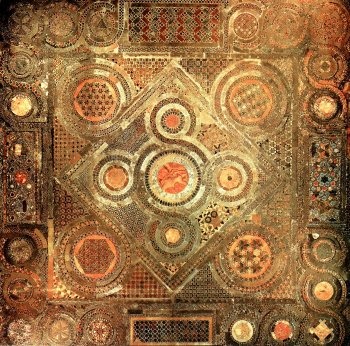In front of the high altar in Westminster Abbey lies an intricate Cosmati mosaic made of exotic colored marble, glass and gemstones so delicate that it has been covered up for much of the 20th century.
 Even Queen Elizabeth II had to stand on carpeting during her coronation because it was deemed too perilous to perch the throne, flunkies and other imperial accoutrements on the mosaic proper as had been done for 6 centuries before.
Even Queen Elizabeth II had to stand on carpeting during her coronation because it was deemed too perilous to perch the throne, flunkies and other imperial accoutrements on the mosaic proper as had been done for 6 centuries before.
Now that a two-year restoration program has begun, the layers of carpeting have finally been removed so visitors may actually get a glimpse of the beauty.
The wraps have come off one of Westminster Abbey’s least known treasures, a medieval marble pavement foretelling the end of the world, while conservation experts consider how to preserve the ancient stones for the next 740 years.
Few modern visitors have ever seen it, although since 1268 kings and princes, queens and cardinals have walked across a symbol laden mosaic as intricate as a piece of jewellery.
It is made up of rare marbles and gemstones, including some recycled from monuments 1,000 years older, and pieces of coloured glass, set in complex allegorical patterns into a framework of Purbeck marble cut as intricately as a jigsaw puzzle.
The allegory of the shapes apparently contains references to the end of the world, as does an inscription that is now almost entirely gone but was transcribed in the 15th century:
If the reader wittingly reflects upon all that is laid down,
he will discover here the end of the primum mobile:
the hedge lives for three years,
add in turn dogs, and horses and men
stags and ravens, eagles, huge sea monsters, the world;
each that follows triples the years of the one before.
Cool, huh? I do love a quality obscure-metaphor-packed apocalyptic code. Here’s a neat interpretation of the inscription.
This inscription refers to the medieval belief that the earth was fixed at the centre of nine moving spheres, which carried the sun, moon, five known planets, and the fixed stars. The ninth and outermost sphere, beyond the fixed stars, was called the “primum mobile” (first moved) because it was thought to be the sphere set in motion by God, which provided the motive power of all the other spheres.
“The end of the primum mobile” means the age of the universe when it will come to an end – at the Day of Judgement. The verse claims that this can be calculated by tripling the life-spans of God’s other creations. So the hedge, standing for three years, is tripled to give the life-span of a dog (nine years), which in turn is tripled to give the life-span of a horse (27 years). The final age, the life-span of the primum mobile, is 19,683 years – three raised to the power of nine. This was appropriate for the age of the ninth sphere.
That’s a pretty generous End of Days assessment. How are you supposed to get a bevy of adoring supine girls and the entire contents of their daddy’s bank accounts when the apocalypse is 20 thousand years away?
